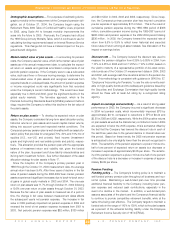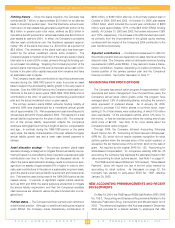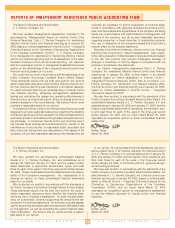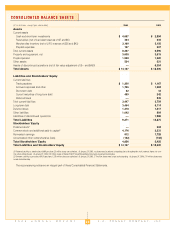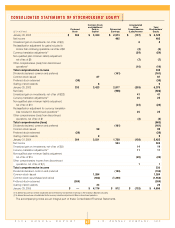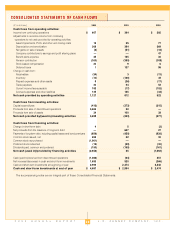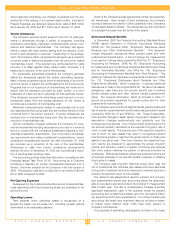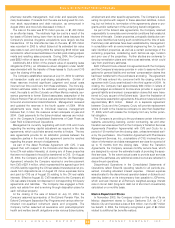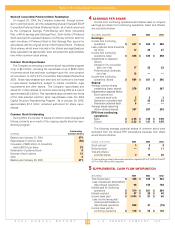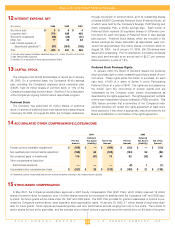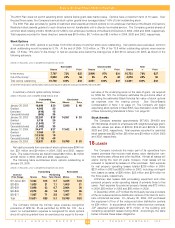JCPenney 2004 Annual Report Download - page 32
Download and view the complete annual report
Please find page 32 of the 2004 JCPenney annual report below. You can navigate through the pages in the report by either clicking on the pages listed below, or by using the keyword search tool below to find specific information within the annual report.
J.C. PENNEY COMPANY, INC.2 004 ANNUAL REPORT
Notes to the Consolidated Financial Statements
30
direct response advertising, are charged to expense over the pro-
ductive life of the catalog, not to exceed eight months. Included in
Prepaid Expenses are deferred catalog book costs of $58 million
as of January 29, 2005 and $77 million as of January 31, 2004.
Vendor Allowances
The Company receives vendor support in the form of cash pay-
ments or allowances through a variety of programs, including
cooperative advertising, markdown reimbursements, vendor com-
pliance and defective merchandise. The Company has agree-
ments in place with each vendor setting forth the specific condi-
tions for each allowance or payment. Depending on the arrange-
ment, the Company either recognizes the allowance as a reduction
of current costs or defers the payment over the period the related
merchandise is sold. If the payment is a reimbursement for costs
incurred, it is offset against those related costs; otherwise, it is
treated as a reduction to the cost of merchandise.
For cooperative advertising programs, the Company generally
offsets the allowances against the related advertising expense.
Many of these programs require proof-of-advertising to be provid-
ed to the vendor to support the reimbursement of the incurred cost.
Programs that do not require proof-of-advertising are monitored to
ensure that the allowance provided by each vendor is a reim-
bursement of costs incurred to advertise for that particular vendor.
If the allowance exceeds the advertising costs incurred on a ven-
dor-specific basis, then the excess allowance for the vendor is
recorded as a reduction of merchandise cost.
Markdown reimbursements related to merchandise that is sold
are negotiated by the buying team and are credited directly to Cost
of Goods Sold in the period received. If vendor allowances are
received prior to merchandise being sold, they are recorded as a
reduction of merchandise cost.
Vendor compliance charges reimburse the Company for incre-
mental merchandise handling expenses incurred due to a vendor’s
failure to comply with the Company’s established shipping or mer-
chandise preparation requirements. Due to the strict recordkeep-
ing requirements and related cost/benefit considerations, vendor
compliance arrangements entered into after December 31, 2002
are recorded as a reduction of the cost of the merchandise.
Allowances or cash from vendor compliance arrangements
entered into prior to December 31, 2002 are recorded as a reduc-
tion of merchandise handling costs.
The accounting policies described above are in compliance with
Emerging Issues Task Force 02-16, “Accounting by a Customer
(Including a Reseller) for Certain Consideration Received from a
Vendor,” and were adopted by the Company in the first quarter of
2003. This adoption resulted in a reduction to net income of $9 mil-
lion in 2003 compared to 2002.
Pre-Opening Expenses
Subsequent to the construction/buildout period of store facilities,
costs associated with the pre-opening phase are expensed in the
period incurred.
Operating Leases
Rent expense under operating leases is recognized on a
straight-line basis over the lease term, including renewal options
determined to be reasonably assured.
Some of the Company’s lease agreements contain developer/ten-
ant allowances. Upon receipt of such allowances, the Company
records a deferred rent liability in Other Liabilities on the Company’s
Consolidated Balance Sheets. The allowances are then amortized
on a straight-line basis over the terms of the leases.
Retirement-Related Benefits
In December 2003, the Financial Accounting Standards Board
(FASB) issued Statement of Financial Accounting Standards
(SFAS) No. 132 (revised 2003), “Employers’ Disclosures about
Pensions and Other Postretirement Benefits.” This statement
revised employers’ disclosures about pension plans and other
postretirement benefit plans. It did not change the measurement
or recognition of those plans required by SFAS No. 87, “Employers’
Accounting for Pensions,” SFAS No. 88, “Employers’ Accounting
for Settlements and Curtailments of Defined Benefit Pension Plans
and for Termination Benefits,” and SFAS No. 106, “Employers’
Accounting for Postretirement Benefits Other Than Pensions.” This
statement retained the disclosure requirements contained in SFAS
No. 132, “Employers’ Disclosures about Pensions and Other
Postretirement Benefits,” which it replaced. It requires additional
disclosures to those in the original SFAS No. 132 about the assets,
obligations, cash flows and net periodic benefit cost of defined
benefit pension plans and other defined benefit postretirement
plans. The required information, which is included in Note 17,
should be provided separately for pension plans and for other
postretirement benefit plans.
The Company accounts for its defined benefit pension plans and
its non-pension postretirement benefit plans using actuarial models
required by SFAS No. 87 and SFAS No. 106. These models effec-
tively spread changes in asset values, the pension obligation and
assumption changes systematically and gradually over the
employee service periods. One of the principal components of the
net periodic pension calculation is the expected long-term rate of
return on plan assets. The required use of the expected long-term
rate of return on plan assets may result in recognized pension
income that is greater or less than the actual returns on those plan
assets in any given year. Over time, however, the expected long-
term returns are designed to approximate the actual long-term
returns, and therefore, result in a pattern of income and expense
that more closely matches the pattern of services provided by
employees. Differences between actual and expected returns are
recognized gradually in net periodic pension expense or offset by
future gains or losses.
The Company uses long-term historical actual return data, the
mix of investments that comprise plan assets and future estimates
of long-term investment returns by reference to external sources to
develop its expected return on plan assets.
The discount rate assumptions used for pension and non-pen-
sion postretirement benefit plan accounting reflect the rates avail-
able on AA-rated corporate bonds on the October 31 measurement
date of each year. The rate of compensation increase is another
significant assumption used in the actuarial model for pension
accounting and is determined based upon the Company’s histori-
cal experience and future expectations. For retiree medical plan
accounting, the health care cost trend rates do not have a materi-
al impact since defined dollar limits have been placed on
Company contributions.
For purposes of estimating demographic mortality in the meas-


